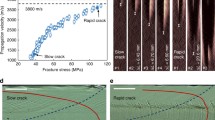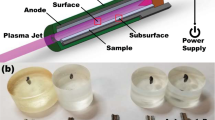Abstract
Fracture surface studies have been made on pre-cracked tungsten single crystals pulled in [010] at temperatures between 200 and 3000K. The cracks were introduced by a spark technique and were atomically sharp. The appearance of the cleavage face varied with crack propagation stress and temperature. At low stresses and low temperatures a large proportion of the surface was ‘mirror’ smooth. Using oblique illumination the smooth surface was found to be covered with Wallner lines which started either at the edge of the crystal or at small cleavage steps. As the stress and temperature increased the area of smooth surface became progressively smaller and was restricted eventually to a narrow spike along [001]. The density of river lines also increased. A number of boundaries separating regions of different river line density were observed which spread out from the side of the fracture surfaces and were attributed to interaction between the stress field at the tip of the crack and a transverse elastic stress wave. The velocity of the cleavage cracks was estimated from the shape of the Wallner lines and from the shape of the river line boundaries. The limiting crack velocity approached 0.60 and 0.82 of the velocity of transverse elastic waves at 77° and 20°K respectively. At higher temperatures, in the presence of river lines, the velocity was between 0.20 and 0.55 of the transverse elastic wave velocity.
Résumé
Des études de surfaces de fracture sont faites sur des monocristaux de tungstène orientés suivant [010] et prefissurés a des températures comprises entre 20°K et 300°K. Les fissures sont introduites par une technique d' étincelle et sont atomiquement aiguës.
L' apparition de la face de clivage varie avec la contrainte de propagation de fissure et la température. Pour de faibles contraintes et de basses températures, une grande proportion de la surface est parfaitement lisse. Sons éclairage oblique, la surface lisse apparait couverte de lignes de Wallner partant soit de l' arête du cristal, soit de petits degrés de clivage. Lorsque la contrainte et la température augmentent, faire de la surface lisse devient progressivement plus petite et se réduit éventuellement à une étroite pointe le long de [001] . La densité des ‘lignes de riviere’ (river lines) augmente également. Un nombre de limites séparant des régions à densité de lignes de rivière différente sont observées; elles s'étendent du cõté des surfaces de la fracture et sont attribuées à l'interaction entre le champ de contrainte an sommet de la fissure et une onde de contrainte élastique transversale. La vitesse des fissures de clivage est estimée d'après la forme de lignes de Wallner et d' après la forme des limites de la ligne de rivière, la vitesse de fissuration limite approche 0,60 et 0,82 de la vitesse d'ondes élastiques transversales à 77°K et 20°K respectivement. Pour des temperatures plus élevées, en présence de lignes de rivières, la vitesse se trouve entre 0,22 et 0,55 de la vitesse de l' onde élastique transversale.
Zusammenfassung
Es wurden Bruchflachen in Wolfram -Einzelkristallen untersucht, die zuvor mit durch Funkenbildung erzeugten, atom-scharfen Rissen versehen worden waren. Die Zugversuche an den Kristallen erfolgten in Richtung [010] bei Temperaturen zwischen 20° and 300°K.
Das Aussehen der Spaltfläche war von Zugspannung and Temperatur bei der Rissausbreitung abhängig. Bei niedriger Spannung and Temperatur war die Fläche zum Grossteil spiegelglatt. Dutch schräge Anleuchtung konnte festgestellt werden, dass die glatte Fläche mit Wallner-Linien bedeckt war, welche entweder an der Kristallkante oder an kleinen Spaltstufen ihren Ausgangspunkt hatten. Bei steigender Spannung and Temperatur wurde der Anteil der glatten Oberfläche zunehmend geringer and schliesslich auf eine schmale Spitze tangs [001] beschraänkt.
Die Dichte der Flusslinien nahm ebenfalls zu. Eine Anzahl Grenzlinien, welche Gebiete verschiedener Flussliniendichte voneinander trennten and sich von der Bruchflache aus erstreckten, wurde beobachtet. Das Auftreten von Grenzlinien wurde auf die Wechselwirkung zwischen dem Spannungsfeld an der Spitze der Risse und einer transversalen elastischen Spannungswelle zuruckgeMhrt. Die Abschatzung der Geschwindigkeit der Spaltrisse erfolgte aufgrund der Form der Wallner-Linien und der Grenzlinien. Der Grenzwert der Rissgeschwindigkeit näherte sich 0,60 and 0,82 mal der Geschwindigkeit der transversalen elastischen Welle bei entsprechend 77° and 20°K. Bei höherer Temperatur and bei Vorhandensein von Flusslinien lag die Geschwindigkeit zwischen 0,20 and 0,55 mal der Geschwindigkeit der transversalen elastischen Welle.
Similar content being viewed by others
References
J. J. Gilman Fracture, J.Wiley and Sons, New York, 193 (1959).
J.J. Gilman, C. Knudsen, and W.P. Walsh J. Appl. Phys., 29, 601 (1958).
M. G. Tattersall and J. P. Clarke Phil. Mag., 7,1977 (1962).
R.J. Stokes and C.H. Li Fracture of Solids, J.Wiley and Sons, New York, 289 (1963).
A.S. Tetelman and W.D. Robertson Acta Met., 11, 415 (1963).
A.S. Tetelman Fracture J. Wiley and Sons, New York, p.415. (1959).
M. Gell and W. D. Robertson Acta Met., 12, 108 (1964).
P.Beardmore and D.Hull J.Inst.Metals, to be published (1965).
D. Hull, P. Beardmore, and A. Valintine, Phil.Mag., 12, 1021 (1965)
J.F. McNeil and H.R. Limb J.Inst.Metals, 87, 79 (1958).
H.R. Limb J. Inst. Metals, 92, 423 (1963–64).
A. Smekal Glastechn. Ber., 23, 57 (1950).
E.B. Shand J. Amer. Ceram. Soc., 37, 52 and 35, 559 (1954).
H. Wallner Z. Physik, 114, 368 (1939).
S.J. Wright Proc. Roy. Soc. (London) A 126, 613 (1930).
E. F. Poncelet Fracturing of Metals, Amer. Soc. Metals, Cleveland, 201 (1951).
N. F. Mott Engineering, 165, 16 (1948).
D. K. Roberts and A. A. Wells Engineering, 178, 820 (1954).
A.N. Stroh Advances in Physics, 6, 418 (1957).
D. M. Marsh Tube Investments, Tech.Rept.No. 161 (963).
M.Gell Thesis Dissertation, Yale University (1965).
Author information
Authors and Affiliations
Rights and permissions
About this article
Cite this article
Hull, D., Beardmore, P. Velocity of propagation of cleavage cracks in Tungsten. Int J Fract 2, 468–487 (1966). https://doi.org/10.1007/BF00183824
Received:
Issue Date:
DOI: https://doi.org/10.1007/BF00183824




